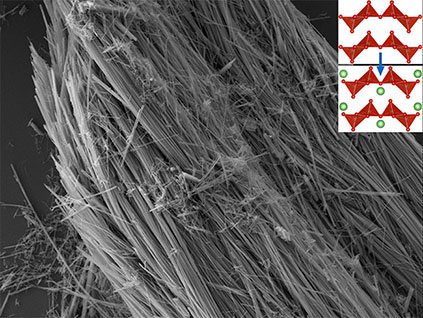| Posted: May 30, 2017 |
Scientists see electron bottleneck in simulated battery
(Nanowerk News) As the appetite grows for more efficient vehicles and mobile devices based on cleaner, renewable energy sources, so does the demand for batteries that pack more punch, last longer, and charge or discharge more quickly. The compound vanadium pentoxide has grabbed the spotlight as a way to improve lithium-ion batteries. However, it’s less-than-stellar behavior has been problematic.
|
|
An international team working at the Molecular Foundry revealed why the material may not perform as expected. The team discovered how interactions between electrons and ions slow the performance of electrodes made with vanadium pentoxide (Nature Communications, "Mapping polaronic states and lithiation gradients in individual V2O5 nanowires").
|
|
This work answers, in part, why the material gets bogged down. Vanadium pentoxide’s layered atomic structure results in a vast surface area, but a bottleneck occurs. If scientists can address the bottleneck, this material may lead to the next generation of batteries, which pack more punch, last longer, and charge or discharge more quickly.
|
 |
| A scanning electron microscopy image of vanadium pentoxide nanowires. The inset shows a ball-and-stick model of vanadium pentoxide’s atomic structure before and after inserting lithium ions (green). (Image: Texas A&M University)
|
|
An international team of scientists working at the Molecular Foundry has revealed how interactions between electrons and ions can slow down the performance of vanadium pentoxide, a material considered key to the next generation of batteries.
|
|
The compound vanadium pentoxide has grabbed the spotlight as a potential nanostructured material for state-of-the-art lithium-ion batteries because it can provide a greater surface area for the arrival and insertion of lithium ions. That quality makes vanadium pentoxide a good candidate as a cathode, the part of a battery where electrons and lithium ions enter.
|
|
The speed with which electrons can enter and exit the cathode determines how much power the battery can provide. The entry and exit speed also determine how quickly a battery recharges.
|
|
Power density and charging are both critical factors in the world of mobile electronics or electrification of our automotive fleet. But despite vanadium pentoxide’s potential, it has yet to be widely adopted commercially because of its less-than-stellar performance when put to the test in the real world.
|
|
The new findings shed light on the slowdown. The results show that the flow of electrons in vanadium pentoxide nanowires gets bogged down as it interacts with lithium ions in a phenomenon known as small polaron formation.
|
|
The research group, which involved scientists at Texas A&M University, made 2D maps of the electronic properties of synthesized vanadium pentoxide nanowires serving as a model lithium-ion cathode using scanning transmission x-ray microscopy at the Canadian Light Source. They came to the Molecular Foundry to interpret their findings.
|

